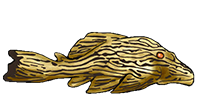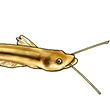Mystery Synodontis
-
toddnbecka
- Posts: 133
- Joined: 26 Oct 2004, 08:49
- My cats species list: 1 (i:0, k:0)
- Location 1: Cumberland, MD
- Interests: Synodontis
Mystery Synodontis
Sorry I don't have a pic, just traded off the catfish, but it was a Synodontis of some sort, completely black except for a few small silver "flakes" on its sides. It also had an elongated top ray on its tail, grew rather quickly, several inches in several months. There are still a few little ones about 1.5-2 inches available at wal-mart here, which is where this one came from.I haven't been able to find a picture of it anywhere as an identified species. I started with 4, and ended with 1 in a 55 gallon tank. In the tank at wal-mart, they all look pretty beat-up, and seem pretty aggressive toward each other even at such a small size, which is why I no longer have the sole survivor. I plan on adding some petricolas to my tank, and didn't trust the mystery cat. Other than that, I really liked the fish, it was beautiful and healthy, though it stayed out of sight most of the time.
-
toddnbecka
- Posts: 133
- Joined: 26 Oct 2004, 08:49
- My cats species list: 1 (i:0, k:0)
- Location 1: Cumberland, MD
- Interests: Synodontis
You are right, and thanks for the pics, it was a Mystus. No wonder I couldn't find it, it looks too much like a Syno, and spends most of its time swimming upside down. I can understand why they aren't aquarium breeders, they would rather fight among themselves than mate. Maybe in a really big tank...
- sidguppy
- Posts: 3827
- Joined: 18 Jan 2004, 12:26
- My articles: 1
- My images: 28
- My aquaria list: 5 (i:0)
- Spotted: 9
- Location 1: Southern Netherlands near Belgium
- Location 2: Noord Brabant, Netherlands
- Interests: African catfishes and oddballs, Madagascar cichlids; stoner doom and heavy rock; old school choppers and riding them, fantasy novels, travelling and diving in the tropics and all things nature.
- Contact:
or in a really big group.
nasty fish often can be kept in groups larger than 8....but few people dare to buy 8 of those critters. (the same with Synodontis angelicus, for example)
and they DO get fairly large.
however; a 150G+/600+ liter tank with 8 Mystus would be a stunning display, and -apart from their nastyness- they're quite easy to keep and feed.
Anybody ever up to the challenge of setting up a 3K tank with 8 Mystus wycki?



nasty fish often can be kept in groups larger than 8....but few people dare to buy 8 of those critters. (the same with Synodontis angelicus, for example)
and they DO get fairly large.
however; a 150G+/600+ liter tank with 8 Mystus would be a stunning display, and -apart from their nastyness- they're quite easy to keep and feed.
Anybody ever up to the challenge of setting up a 3K tank with 8 Mystus wycki?
Valar Morghulis
-
toddnbecka
- Posts: 133
- Joined: 26 Oct 2004, 08:49
- My cats species list: 1 (i:0, k:0)
- Location 1: Cumberland, MD
- Interests: Synodontis
When I do get around to setting up a tank big enough, I plan on keeping african cichlids and Synodontis petricola, smaller, much more sociable, and I would think, easier to sell when they spawn. I know some people love aggressive fish, but usually they don't have tanks big enough to keep them properly, and end up getting rid of them, at least that's what my friends at the local pet shops tell me. If the Mystus were more popular among cichlid keepers, it wouldn't be a bad idea to breed them, but who wants or needs a couple hundred catfish that aren't very popular or even well-known, when the selling price isn't even very high. I agree that they would make quite a display, but personally, I dont have the resources to dedicate to such a speculative endeavor. I would rather try it with S. angelicus, and be the first to spawn those in an aquarium.
After learning that S. multipunctatus doesn't mature sexually for 3-5 years, I wonder if the same is true for other species of Synodontis as well. That could account for the lack of breeding in aquariums, as well as the general cost of most species.
After learning that S. multipunctatus doesn't mature sexually for 3-5 years, I wonder if the same is true for other species of Synodontis as well. That could account for the lack of breeding in aquariums, as well as the general cost of most species.
-
corybreed
- Expert
- Posts: 919
- Joined: 23 Mar 2004, 23:39
- I've donated: $54.00!
- My catfish: 8
- My cats species list: 74 (i:8, k:0)
- Spotted: 6
- Location 1: Long Island, New York, USA
- Location 2: Long Island
- sidguppy
- Posts: 3827
- Joined: 18 Jan 2004, 12:26
- My articles: 1
- My images: 28
- My aquaria list: 5 (i:0)
- Spotted: 9
- Location 1: Southern Netherlands near Belgium
- Location 2: Noord Brabant, Netherlands
- Interests: African catfishes and oddballs, Madagascar cichlids; stoner doom and heavy rock; old school choppers and riding them, fantasy novels, travelling and diving in the tropics and all things nature.
- Contact:
actually there's a fair number of Syno's that get bred in captivity;
and the ones from Tanganyika are usually bred without hormones too.
you should be able to get F-somethings from:
-Synodontis petricola "dwarf" from Zambia
-Synodontis multipunctatus; both Burundi and Zambian varieties are bred by using cichlid-hosts
-Synodontis "multipunctatus Goldeneye"; another chuckoo, but small with many spots. this one's from the southern part of the lake too.
-Synodontis "polli White" or "polli white Zambia", this one's usually sold as the true polli, but that's a very different fish.
and exceptional:
-true Synodontis petricola (northern variety)
-Synodontis polli
both species have been bred -sporadically- in very small numbers. the latter is still sold as 'eurystomus' on occasion; especially by people who sell the "polli white" as "polli".
Other species that HAVE been bred by using hormones or otherwise (usually in country of origin), but still aren't hybrids include:
-Synodontis nigriventris
-Synodontis nigrita
-Synodontis angelicus
-Synodontis decorus
-Synodontis robbianus
and perhaps a few more.
these species show up in larger numbers, all similar sized juveniles. but some aren't suitable for the Rift-cichlid setup.
Wildcaught S dhnoti, S granulosus, S nigromaculatus, S njassae and the species from Tanganyika mentioned above are well suited for the Rifttank; at least polli, petricola, multipunctatus and related varieties stay small too.
and the ones from Tanganyika are usually bred without hormones too.
you should be able to get F-somethings from:
-Synodontis petricola "dwarf" from Zambia
-Synodontis multipunctatus; both Burundi and Zambian varieties are bred by using cichlid-hosts
-Synodontis "multipunctatus Goldeneye"; another chuckoo, but small with many spots. this one's from the southern part of the lake too.
-Synodontis "polli White" or "polli white Zambia", this one's usually sold as the true polli, but that's a very different fish.
and exceptional:
-true Synodontis petricola (northern variety)
-Synodontis polli
both species have been bred -sporadically- in very small numbers. the latter is still sold as 'eurystomus' on occasion; especially by people who sell the "polli white" as "polli".
Other species that HAVE been bred by using hormones or otherwise (usually in country of origin), but still aren't hybrids include:
-Synodontis nigriventris
-Synodontis nigrita
-Synodontis angelicus
-Synodontis decorus
-Synodontis robbianus
and perhaps a few more.
these species show up in larger numbers, all similar sized juveniles. but some aren't suitable for the Rift-cichlid setup.
Wildcaught S dhnoti, S granulosus, S nigromaculatus, S njassae and the species from Tanganyika mentioned above are well suited for the Rifttank; at least polli, petricola, multipunctatus and related varieties stay small too.
Valar Morghulis
I add to the list:-Synodontis petricola "dwarf" from Zambia
-Synodontis multipunctatus; both Burundi and Zambian varieties are bred by using c*****d-hosts
-Synodontis "multipunctatus Goldeneye"; another chuckoo, but small with many spots. this one's from the southern part of the lake too.
-Synodontis "polli White" or "polli white Zambia", this one's usually sold as the true polli, but that's a very different fish.
and exceptional:
-true Synodontis petricola (northern variety)
-Synodontis polli
both species have been bred -sporadically- in very small numbers. the latter is still sold as 'eurystomus' on occasion; especially by people who sell the "polli white" as "polli".
Other species that HAVE been bred by using hormones or otherwise (usually in country of origin), but still aren't hybrids include:
-Synodontis nigriventris
-Synodontis nigrita
-Synodontis angelicus
-Synodontis decorus
-Synodontis robbianus
and perhaps a few more.
Synodontis schoutedeni
Synodontis ocellifer
Synodontis eupterus
Synodontis pleurops
Well i wish i was a catfish
swimmin in a oh, deep, blue sea (Muddy Waters, Catfish blues)
swimmin in a oh, deep, blue sea (Muddy Waters, Catfish blues)
- sidguppy
- Posts: 3827
- Joined: 18 Jan 2004, 12:26
- My articles: 1
- My images: 28
- My aquaria list: 5 (i:0)
- Spotted: 9
- Location 1: Southern Netherlands near Belgium
- Location 2: Noord Brabant, Netherlands
- Interests: African catfishes and oddballs, Madagascar cichlids; stoner doom and heavy rock; old school choppers and riding them, fantasy novels, travelling and diving in the tropics and all things nature.
- Contact:
Strange how it goes.In here it seems impossible to get those Tangayika synos besides multipuctatus and common petricola.I haven`t seen ocellifer for years.It used to be very common species.Schoutedeni is always available and little angelicus.These are at the moment available in Finland:
Synodontis alberti
Synodontis angelicus
Synodontis aterrimus
Synodontis brichardi
Synodontis budgetti
Synodontis camelopardalis
Synodontis decorus
Synodontis eburneensis
Synodontis eupterus
Synodontis flavitaenius
Synodontis acanthomias
Synodontis nigriventris
Synodontis notatus
Synodontis pleurops
Synodontis robbianus
Synodontis schoutedeni
Synodontis njassae
Synodontis soloni
Synodontis alberti
Synodontis angelicus
Synodontis aterrimus
Synodontis brichardi
Synodontis budgetti
Synodontis camelopardalis
Synodontis decorus
Synodontis eburneensis
Synodontis eupterus
Synodontis flavitaenius
Synodontis acanthomias
Synodontis nigriventris
Synodontis notatus
Synodontis pleurops
Synodontis robbianus
Synodontis schoutedeni
Synodontis njassae
Synodontis soloni
Well i wish i was a catfish
swimmin in a oh, deep, blue sea (Muddy Waters, Catfish blues)
swimmin in a oh, deep, blue sea (Muddy Waters, Catfish blues)
- sidguppy
- Posts: 3827
- Joined: 18 Jan 2004, 12:26
- My articles: 1
- My images: 28
- My aquaria list: 5 (i:0)
- Spotted: 9
- Location 1: Southern Netherlands near Belgium
- Location 2: Noord Brabant, Netherlands
- Interests: African catfishes and oddballs, Madagascar cichlids; stoner doom and heavy rock; old school choppers and riding them, fantasy novels, travelling and diving in the tropics and all things nature.
- Contact:
WOW!
impressive list, MIKA
here it's much shorter!
-S multipunctatus
-S multipunctatus Goldeneye
-S petricola dwarf
-S dhonti
-S polli
-S 'polli White'
-S granulosus
-S nigriventris
-S nigrita
-S robbianus
-S eupterus
-S angelicus
-S decorus.
that's it.
for others you have to cross the border to either Belgium or Germany.
So we have it very good, if you're into Lake Tanganyika fish (luckily, I'm into that; other Tang-cats are available too), but if riverines are your cup o' tea, it's not that good.
impressive list, MIKA
here it's much shorter!
-S multipunctatus
-S multipunctatus Goldeneye
-S petricola dwarf
-S dhonti
-S polli
-S 'polli White'
-S granulosus
-S nigriventris
-S nigrita
-S robbianus
-S eupterus
-S angelicus
-S decorus.
that's it.
for others you have to cross the border to either Belgium or Germany.
So we have it very good, if you're into Lake Tanganyika fish (luckily, I'm into that; other Tang-cats are available too), but if riverines are your cup o' tea, it's not that good.
Valar Morghulis




